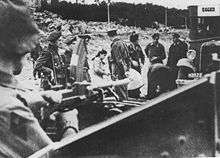Security checkpoint
Civilian checkpoints or security checkpoints are distinguishable from border or frontier checkpoints in that they are erected and enforced within contiguous areas under military or paramilitary control. Civilian checkpoints have been employed within conflict-ridden areas all over the world to monitor and control the movement of people and materials in order to prevent violence.
Contemporary examples

Though practices and enforcement vary, checkpoints have been used in:
- The former Yugoslavia during the Yugoslav Wars.
- Northern Ireland by the Official IRA, Provisional IRA, Irish National Liberation Army, and Real IRA as well as by the British Army, Royal Ulster Constabulary, Police Service of Northern Ireland and also by the Ulster Defense Association and the Ulster Volunteer Force.
- Colombia, by military and paramilitary forces.
- Palestinian territories, by the Israeli Defence Force.
- Mexico, by military and police forces.
- Since the terrorist bombings in Pakistan, they are widely seen across all over Pakistan specially on entrance and exit points of big cities.
Advantages
Checkpoints provide many advantages, including the ability to control how people enter so that security personnel (be it governmental or civilian) can screen entrants to identify known troublemakers (be they criminals, terrorists, or simple rabble-rousers) and locate contraband items.
Effects of checkpoints
Checkpoints typically lead to hardship for the affected civilians, though these effects range from inconvenience to mortal danger. Bir Zeit University, for example, has conducted several studies highlighting the effects of checkpoints in the Palestinian territories.[1][1][2]
In Colombia, the paramilitary forces of the AUC have, according to Amnesty International, imposed limits on the food entering villages, with over 30 people being killed at the checkpoint in one instance.[3]
See also
- Airport security
- Border checkpoint
- Flying checkpoint
- Freedom of movement
- Israeli checkpoints
- Random checkpoint

